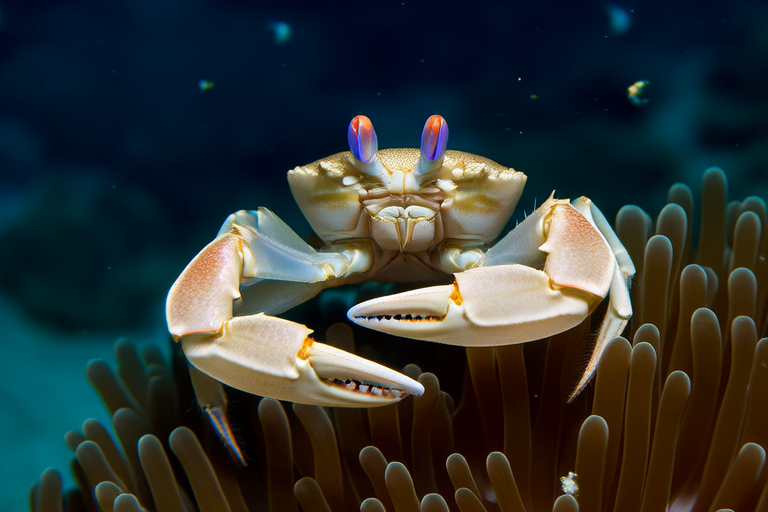The Unique Lifecycle and Adaptations of Pea Crabs: A Marine Biologist’s Perspective
Welcome to an exploration of the fascinating world of pea crabs, tiny crustaceans that have mastered the art of survival through symbiosis. These diminutive creatures, no larger than a fingernail, have evolved to live within the shells of sea creatures such as mussels and sea cucumbers. Their unique lifecycle and adaptations offer valuable insights into the complex relationships within marine ecosystems.
Pea Crabs’ Lifecycle and Adaptations
Pea crabs, belonging to the family Pinnotheridae, are known for their remarkable adaptations. They begin life as free-swimming larvae, floating in the open ocean. Once they reach a certain size, they seek out hosts, typically bivalves like mussels or sea cucumbers. This transition marks the beginning of their symbiotic relationship, which is crucial for their survival. The host provides protection from predators and a steady supply of food, while the pea crab, in turn, helps its host by consuming parasites and debris.
One of the most intriguing aspects of pea crabs is their ability to adapt to different environments. Some species have even been found living inside the mantles of scallops or the gills of sea cucumbers. This versatility showcases the evolutionary success of these creatures in finding suitable habitats within their aquatic world.
Symbiotic Relationship with Sea Creatures
The symbiotic relationship between pea crabs and their hosts is mutually beneficial. For instance, when a pea crab settles into a mussel, it gains access to nutrients and protection from predators. In return, the pea crab assists the mussel by feeding on detritus and small organisms that could otherwise clog the mussel’s filtration system. This partnership underscores the interconnectedness of marine life and highlights the importance of maintaining balanced ecosystems.
In addition to mussels, pea crabs have also been observed living in sea cucumbers. These echinoderms provide a safe haven for the crabs, who can move freely within the cucumber’s body cavity. This arrangement benefits both parties, as the sea cucumber receives cleaning services from the pea crabs, helping to keep its internal environment clean and healthy.
Studying Pea Crabs: Marine Biologists’ Approach
Marine biologists have long been fascinated by pea crabs and their unique lifestyle. Traditional methods of studying these creatures involved collecting samples from their hosts and analyzing them in laboratory settings. However, advancements in underwater technology have revolutionized our ability to observe pea crabs in their natural habitat. Underwater cameras, remotely operated vehicles (ROVs), and diving equipment now allow researchers to document the daily lives of these tiny crustaceans without disturbing them.
These tools enable scientists to capture detailed images and videos of pea crabs interacting with their hosts. By observing these interactions firsthand, researchers gain valuable insights into the behaviors and adaptations of pea crabs. This information is essential for understanding the role of pea crabs within their ecosystems and for developing effective conservation strategies.
Recent Findings and Changes in Their Ecosystem
Recent studies have shed light on several aspects of pea crabs’ lives. For example, researchers have discovered that some species of pea crabs exhibit sexual dimorphism, meaning males and females have distinct physical characteristics. Males are often smaller and more agile, while females tend to be larger and more robust. This difference in size and shape may reflect their roles within the symbiotic relationship, with males being responsible for mating and females ensuring the survival of their offspring.
Additionally, changes in the marine environment, such as rising sea temperatures and ocean acidification, have begun to affect pea crabs and their hosts. Some species of mussels and sea cucumbers have shown signs of stress under these conditions, which could impact the symbiotic relationship with pea crabs. As a result, marine biologists are closely monitoring the health of these ecosystems to understand the potential consequences for pea crabs and other marine life.
The Importance of Understanding Pea Crabs for Marine Conservation
Understanding pea crabs is crucial for marine conservation efforts because these tiny creatures play a significant role in maintaining the balance of marine ecosystems. By studying pea crabs, researchers can gain insights into the broader health of the oceans and identify potential threats to marine biodiversity. Moreover, protecting pea crabs and their hosts contributes to the preservation of entire ecosystems, ensuring the survival of countless other species that rely on these relationships for their own survival.
As we continue to explore the intricate web of life beneath the waves, it becomes increasingly clear that every organism, no matter how small, has a vital role to play. By learning about pea crabs and their symbiotic relationships, we can better appreciate the complexity of marine ecosystems and work towards preserving them for future generations.
